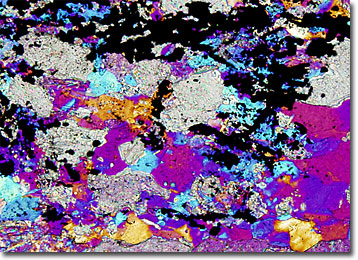Polarized Light Microscopy Digital Image Gallery
Breccia Marble
The term breccia is generally utilized to refer to lithified rock chiefly comprised of angular fragments that are larger than two millimeters in size. Thus, the primary difference between a breccia and a conglomerate is the shape of the particles, since the latter is primarily composed of rounded pebbles or other particles, also larger than two millimeters.

The angular fragments found in breccia marble may be derived from a single rock or many and are often held together by a cementing material, such as silt, silica, iron oxides, or carbonate. In some types of the rock, the cementing material is associated with the clasts it contains, but this is not always the case. When the breccia forms after a landslide or mudslide, for instance, the fragmentary material may be deposited in an unrelated area where the cement forms from a substance not typically connected with the clasts.
Breccia marble is a type of breccia rock that can be polished to a fine luster and is commonly utilized for ornamental purposes. Though all marbles possess a certain beauty, breccia marble is particularly stunning because of the intricate vein-like patterns it typically exhibits. These patterns are a result of the fragmentary nature of the rock, and they may appear in a variety of colors, such as red, green, brown, and beige, depending on their constituent materials. Indeed, breccias are a very diverse group of rocks, but a significant percentage of the breccias utilized for decorative purposes are primarily composed of silica, often in the form of jasper or chert.
